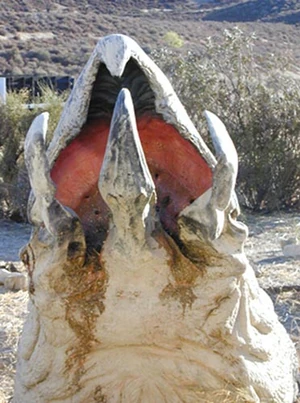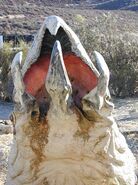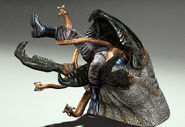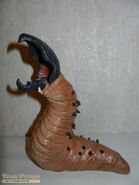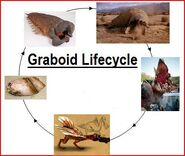| ||||||||||||||
| [Source] | ||||||||||||||
The Graboid, also known as the Dirt Dragon or Tu lung in the 19th century, is a fictional invertebrate species that is the primary antagonist of the Tremors franchise. The creature made its debut in the 1990 film Tremors, and reappeared in all its sequels Tremors 2: Aftershocks (1996), Tremors 3: Back to Perfection (2001), and prequel Tremors 4: The Legend Begins (2004). It was also featured regularly in the series' spin-off Tremors: The Series (2003), with El Blanco being a recurring character.
Life Cycle
It seems that considering the information presented in the movies this entire life cycle can take place in about 9 months, however due to the eggs ability to hibernate for extended periods of time this is likely the reason that the creatures were virtually unknown up until the late 20th century. The 4th Tremors movie is the first chronological reappearance of the Graboids, it begins a time when Graboid pockets are reawakened all over the world as suspected by scientists (according to Burt).
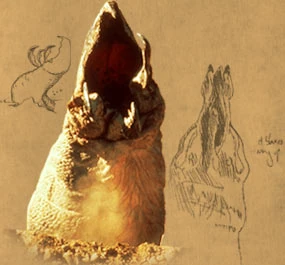
Graboid's picture from Scifi.com
Graboids' Eggs
These are laid by Ass Blasters
Shooter
Shooters are the baby Graboids from Tremors 4, also known as Dirt Dragons and Tu-Long. So far they have only appeared in Tremors 4.
Graboid
The standard Graboid is the only creature to have appeared in all four entries, and also the 2003 TV series of the same name. They are the first stage of the life cycle of their species, followed by the shrieker and Ass Blaster. In Tremors 4: The Legend Begins, which is a prequel taking place in 1889, thus before they got their current name, they are referred to as "dirt dragons". The name "Graboid" was invented by shop owner character in the first film, Tremors, Walter Chang; who was subsequently eaten by one. Promotional material written by the Sci Fi Channel classifies them as Devonian Era invertebrate predators, possibly Cephalopods.
Physiology
Graboids are depicted as subterranean animals, superficially resembling gigantic worms or larva, with long, serpentine bodies. When fully grown, a mature Graboid will measure up to 30 feet long, and 6 feet across at their widest point and weigh 10-20 tons. From the information gained through the knowledge presented in Tremors 4 it takes them about 3 months to attain this size. Anatomically speaking, the Graboid is a tube wrapped with thick skin-muscle, which is necessary to manipulate its external spines. Presumably, it must also possess a semi-rigid internal structure (though not a true endoskeleton) since it can burst through concrete (though such an impact kills it). Less dramatically, the Graboid's ability to lift its upper body into the air, as well as bear the weight of the soil through which it moves, also suggests a semi-rigid internal structure. The internal cuttle-bone structure is probably coupled with a strong musculature. It is logical to assume that a Graboid propels itself underground partly with its surface spines, and partly with an overall motion of its body. A strong internal musculature would enable the Graboid to flex its entire body, undulating in a curling, corkscrew motion through the ground. Graboids completely lack eyes as they live underground. Their heads consist of a massive, black, armored beak, which is used to push aside the dirt whilst digging. The beak opens up like a grotesque flower; it consists of a wide upper jaw, a thinner lower jaw, and a pair of hooked mandibles on either side, they measure three feet long. Whether they possess a skeleton or not is unknown, though a faux scientific document written by the Sci-Fi channel hypotheses they have a semi-rigid internal structure, similar to the internal cuttle-bones of certain cephalopods, such as cuttlefish.
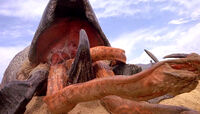
A graboid extends its three, prehensile tongues
Graboids have a trio of long, powerful, serpent-like tentacles, which are prehensile and have a reach of at least ten feet. Normally kept retracted in the Graboid's throat, these tentacles were initially mistaken for the actual creatures, causing the characters in the first Tremors film to underestimate their underground opponents. The Graboid's common name is derived from these prehensile tentacles, which "grab" prey and suck it down the Graboid's hungry gullet. The three "tongues" each have a mouth, teeth and two pairs of horn like projections on the upper jaw and lower jaw. The tentacles are used in other ways besides grasping. Other purposes of these erstwhile appendages include sensing very subtle vibrations and feeling around basically acting as the creatures arms and hands. However, unlike human hands the tentacles have taste sensors inside the mouth-like jaws. So when a tentacle's jaws close on something, the Graboid can quickly tell if the something is worth reeling in to eat. While at times, these tentacles appear to have minds of their own, hissing and writhing like snakes, they, like an octopuses tentacles, are simply extensions of the creature. Food is typically swallowed whole, though early in the original Tremors film, they are shown to dismember and decapitate their prey, this was shown again with the Old Fred of Tremors 4 this likely points to necessity if it senses other prey approaching and needs to start after them. They apparently have a slow metabolism, at least for the sterile ones like El Blanco, as it was only hinted at to defaecate in the last episode of the series.
A Graboid's hide is thick and leathery, with a rough, pebbly texture, giving them a reptilian appearance (though they are not reptiles). This makes them very hard to kill with anything short of saturation bombing or large-bore rounds, usually from guns designed for large animals such as elephants and buffalo. Graboids possess immense physical strength, able to topple over mobile homes, tow along an object heavy as a pickup truck without slowing down, smash through brick walls and pull an entire station wagon underground. Encircling their bodies are short spikes, which all move in unison to push the Graboid through the dirt (more specifically Pleistocene alluvial Soil), similar to the setae on an earthworm. Their top speed is around 15-20 mph in good loose soil. Therefore they are able to burrow faster than a human can run; a Graboid cannot not catch motorized vehicles like cars or dirt bikes, as shown in Tremors 3: Back to Perfection when Jack's truck was able to outrun a Graboid. Also it was been shown throughout the series and Tremors 4 that galloping horses can out pace Graboids. With armored head and mobile spikes working together in unison, a Graboid can "swim" through the loose soil at high speed like a shark in the water, though they are incapable of tunneling through solid rock. Graboids (and their nymph and imago forms, the Shrieker and Ass Blaster respectively) have distinctive orange blood. Graboids also have a powerful stench, which is made evident on several occasions throughout the first film. Though underplayed in the 2nd and 3rd films, the Graboid's stench becomes a critical plot point in Tremors 4; Juan is able to identify the Graboids as being the unseen killers in the silver mines where they are small and jump from the ground extremely fast with a hard shell on their back, hunting by sound, shedding their shells and growing to become matured Graboids later in the film due to them sharing the same vile odor. The Graboids' greatest weakness is that it is unable to tell the terrain of the environment it is in before it's too late, which is demonstrated when Earl and Val trick one into running into a concrete wall, and when Val tricks Stumpy into running off of a cliff.
For obvious reasons, it has been all but impossible to directly observe the creature underground; observations of the surface soil above a Graboid's route, however, show that such soil is sometimes humped erratically, producing a series of rises and falls rather than a continuous ridge. This disturbance of the ground is consistent with a writhing, flexing mode of travel. Furthermore, when a Graboid surfaces, it often does so while turning its head or body in a circular motion, supporting the corkscrew theory of locomotion.
The Graboid appears to respirate the same nitrogen-oxygen atmosphere as other terrestrial animals. Witnesses have heard Graboids sometimes expel blasts of air. This implies that Graboid's possess lungs. Whether these lungs resemble vertebrate lungs is unknown. On a related topic, the Graboid, Shrieker and Ass Blaster all have closed circulatory systems; their reddish-orange blood has been well-documented. This suggests that they possess a cardiopulmonary system, a heart pump and an oxygen-based blood-transport system.
Metabolism
The Graboid would seem to require astonishing levels of energy to propel its prodigious bulk underground faster than a human can run above ground, yet it does so almost routinely when pursuing prey. It is possible that the Graboid spends most of its time in a torpid or dormant state to recover from these short, intense bursts of activity.
The Shriekers' rapid self-replication and the Ass Blaster's ability to generate volatile chemicals capable of launching it skyward suggest extremely efficient metabolisms. Like the Graboid, however, these creatures appear to need rest while digesting food and after prolonged expenditures of energy. Supporting this theory is the observation that, when fully fed, an Ass Blaster collapses into a "food coma" in order to digest and to regain its equilibrium.
Curiously, in addition to its feats of speed and its ability to digest large prey, the Graboid has even shown an occasional willingness to eat metal. One of the creatures swallowed a large metal drum containing Burt Gummer, and there is also a report of Graboids attacking a station wagon. Did the Graboids involved in these incidents attack because their bodies are capable of deriving useful nutrients from inorganic objects? Or, as is considered more likely, did the car's vibrations (or Gummer's movements inside the barrel) mislead the Graboids into thinking they had found living prey?
It is possible that the Graboid's underground life gives it access to elements or chemicals that "supercharge" its digestion and metabolism. Because the surface-dwelling Shrieker and Ass Blaster also show a similar level of digestive/metabolic ability, the discarded body of their parent Graboid might provide them with these required chemicals. It is also possible that this ability is simply inherent in all three species. Regardless, it remains one of the most impressive aspects of their physiology.
Hunting and Intelligence
Graboids are shown to be ravenous carnivores, always on the hunt for food. Indiscriminate eaters, their diet includes but is not limited to sheep, cattle, horses, donkeys, coyotes, and even humans. They are known to be cannibalistic when the opportunity presents itself; El Blanco consumed an Ass Blaster in Tremors 3. Lacking eyes or a nose, they're shown to hunt by sensing seismic vibrations, which are produced by sounds and movements. Because they are unable to tell the difference between edible and inedible vibration sources they adopt a policy of "eat first, ask questions later," simply swallowing whatever sets off their vibration sensors and regurgitate anything that does not taste good. Inedible objects can be spat out with amazing force, being propelled high into the air. Due to the sensitive hearing they use for underground navigation, Graboids are so sensitive to sound they must retreat from loud explosions, which cause them great pain due to sensory overload. For the same reason Graboids are unable to hunt during rain storms. The scientific explanation for this is based on the fact that scientists recently learned that rain is one of the loudest sounds underwater in the ocean.
Graboids are ambush predators, preferring to sneak up on their quarry, though they are shown to chase it down with great determination. They erupt from the ground and use their tentacles to ensnare prey, pulling them into their mouth. The tentacles wrap around the prey, biting into its flesh or hooking the prey with their horn-like spikes. When the prey attempts to flee by climbing, Graboids will simply dig away the earth under the hiding place, undermining it until it collapses or sinks low enough to allow the Graboid to pluck off the hiding prey. When they are unable to break down the prey's hiding spot, the undaunted Graboids will continue circling it like sharks until it ceases making vibrations. Usually they wait so long the prey dies of dehydration or starvation, i.e. several days.
Little is known about the creatures' nervous systems, but all forms of the Graboid appear to have sophisticated brains, at least as compared with other predatory animals. All Graboids have exhibited signs of being extremely quick studies. Science cannot yet measure exactly how smart these creatures are, but they might approach the intelligence levels of such mammalian pack predators as wolves and lions. That being said Graboids are highly intelligent, possessing memory and the ability to learn. For instance, in the first Tremors movie the characters successfully killed a Graboid by having it swallow homemade dynamite. The second Graboid had apparently noticed this trap and simply regurgitated the dynamite. There are plenty of other examples, for instance when the characters escaped on a bulldozer which was too big to be toppled or undermined, the creatures simply dug a trap in its path.
Maturation cycle
Hatching and Science
Graboids hatch from eggs which can lay dormant for at least 300 years, possibly even longer. Abnormal heating (geothermal or radiation) of the soil around a Graboid egg can accelerate its gestation and cause it to hatch sooner.
Once hatched, Graboid worms grow very swiftly into 30-foot-long, sightless, underground eating machines that hunt via their extra-sensitive hearing. They can zero in unerringly on the slightest movement or vibration. It's also worth noting that many people who have survived encounters with Graboids have reported that one can smell the stench of a Graboid long before one actually sees its eel-like hunting appendages.
SAFETY TIP:
When in an area infested with Graboids, it is important to remain absolutely motionless and silent. If you are in a stopped motor vehicle, do not let the engine idle, and be certain to turn off car stereos and any other sound-producing devices, such as portable CD or tape players with headphones.
Folklore
"Spirit Demons from dark places, eating the souls of those who live in the light"
Tecopa, Tremors 4: The Legend Begins
Based on the quote above it could be summarized that besides Speculations in the Department of the Interior Report.[4]
The Graboids seemed to have surfaced enough times in the past thousand years (possibly during an earlier hatching cycle) for them to pass into the traditions of local native american tribes as Tecopa asserts, he seems to ascribe the Greboids predations to being these creatures of legend. This could possible mean that they avoided the valley that became Rejection, and is now Perfection.
This legend may also have the reason that the Proudfoot corporation set up shop in the area.
Origins
For the supposed evolution of the Graboid check out Graboid Evolution.
From where or what the Graboids originate is intentionally kept very vague; the creators of the film were unconcerned with this detail, offering no explanation as to where the Graboids came from in the original film (wanting to avoid the typical clichés of the monster movie genre). The main characters even satirize this convention by attempting to guess where they came from—outer space, nuclear mutations, genetic engineering, and prehistory are all offered up as possible explanations.
The answer was revealed in Tremors 2, when a fossil Graboid spike was discovered and dated back to the Precambrian - the Graboids are apparently from Earth, or have at least existed on Earth for a very long time. Strangely, no prey large enough for Graboids to eat existed on the land at all. A write-up by the Sci-Fi channel for Tremors: The Series rectified this by saying the fossil was incorrectly dated and actually from the Devonian period, though they don't rule out a possible extraterrestrial origin.
Though they resemble worms, in Tremors 3 the United States Department of the Interior calls them "desert reptilians", while an elaborate write-up on the SciFi channel's Tremors: The Series homepage (written in the style of a report by the Department of the Interior) classified them as cephalopods based on their intelligence, beaks and tentacles.[5] This same promotional material gives them their scientific name as seen above.
As a result of the name of the series, "Tremors", many fans colloquially (and incorrectly) refer to the Graboid beasts as "tremors". The result of this was that on-screen in Tremors 3, a tourist erroneously refers to one as a "tremor", only to be corrected by the character "Desert Jack" who replies, "They're called Graboids!"
Notable Individuals
- The albino Graboid, El Blanco.
- And the longest surviving worm in the first movie, who grabbed Val and Earl's truck and long a tongue trying to keep the truck still but loses a tongue at the end; He also is responsible for killing Chang and testing the Houses, such as the Chang's Store, Stumpy.
- A Graboid in mexico who was smart enough to bite/snag the chain hanging off of the end of Earl and Grady's truck and ended up taking them on a joy ride. This ended when the the chain broke upon a rock right just before the Graboid was set to pull them into a boulder. Later Burt would report the duo that he had killed a Graboid with a chain in it's mouth, Prompting Grady to shout "that one was ours".
- There was a dead mounted/stuffed Graboid in Burt's den. This is the Graboid Heather and he killed when it attacked their basement.
- A Graboid in the desert surrounding the town of Toluca, NM learned to recognize the vibrations from Cecil Carr's IGC dish & figured out that people would regularly come by to maintain it, giving it a steady food supply in A Little Paranoia Among the Friends.
Gallery
For additional graboid images and a discussion on the graboid design process, visit [6] and [7].
Appearances
- Tremors
- Tremors 2: Aftershocks (Briefly)
- Tremors 3: Back to Perfection
- Tremors 4: The Legend Begins (As "Rejection")
- Tremors: The Series
References
- ↑ 1.0 1.1 S. S. Wilson (writer), Brent Maddock (writer), [Ron Underwood]] (director); Tremors DVD. Universal Home Entertaiment.
- ↑ http://www.imdb.com/tt100814/fullcredits
- ↑ Tremors 4 audio commentary, Tremors Attack Pack
- ↑ http://web.archive.org/web/20040623151536/www.scifi.com/tremors/monsters/analysis/07_mythology.html
- ↑ http://www.scifi.com/tremors/monsters/analysis/06_taxonomy.html
- ↑ Monster Legacy, "Subterranean Terror — Part I: Tremors". http://monsterlegacy.wordpress.com/2014/09/20/subterranean-terror-part-i-tremors/
- ↑ Monster Legacy. "Monster Gallery: Tremors (1990)". http://monsterlegacy.wordpress.com/2014/09/20/monster-gallery-tremors-1990/

